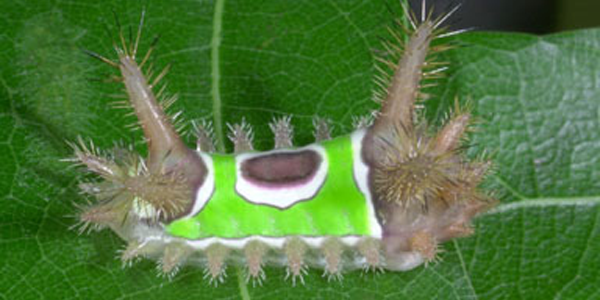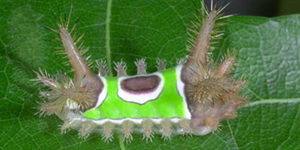Caterpillar Spotting Leads to Citizen Science
An unusual caterpillar brings lots of "eeeews!" and one contribution to a citizen science project. Discover how anyone can collaborate on serious scientific research.

What do you picture when you think of a caterpillar? Green and hairless? Or perhaps black and fuzzy? Recently, I found a caterpillar on my car bumper, and its distinctive looks made me stop in my tracks. With crazy green and brown coloring, horns at both ends, and little spines everywhere, it looked like something out of a Dr. Seuss' book! I decided that this was definitely a look-but-don't-t ouch situation.
After taking a picture, I immediately went online to see if I could figure out what kind of caterpillar it might be. A little sleuthing helped me discover that it was most likely a saddleback caterpillar, or Acharia stimulea, that is native to where I live. Although this wild-looking creature will morph into a decidedly boring brown moth, I was right about not touching it—those spines secrete poison!
Citizen Science Lets Anyone Contribute to Our Knowledge of the World
I enjoyed sharing my photo with friends and family, and I later learned that I could go one step further and share my discovery on a "citizen science" web site called Butterflies and Moths of North America . By submitting my photo and information about where it was taken, I was contributing to the available knowledge about this particular species. How cool that information I collected may be used by scientists in their research!
Butterflies and Moths of North America is just one of many existing citizen science projects. Do a quick online search, and you'll find collaborative projects related to pollinators, astronomy, chemistry, the environment, and much more. These projects offer families and classrooms a simple but meaningful way to participate in scientific research. What a boost for kids to know that their efforts can have an impact outside of their home or school! You can find more detailed information and inspiration about animal-related citizen science that is fun for the whole family in Loree Griffin Burns's book, Citizen Scientists: Be a Part of Scientific Discovery from Your Own Backyard. )
Science Right Outside Your Door
My caterpillar hung onto the car bumper for two days. Figuring that it would be happier living on a food source instead, we very carefully moved it to a plant in the yard. When we checked back later, there was a hole in the leaf, but the caterpillar was gone. Perhaps to start building its cocoon?
Do you have an interest in caterpillars, butterflies, or moths? If so, take a look at these Science Buddies Project Ideas:
- Does Temperature Affect the Rate of Butterfly Development?: Using painted lady butterfly larvae, explore the relationship between temperature and the time it takes for pupae to complete metamorphosis. Why does it matter?
- Build a Better Moth Trap: Will Different-colored Lights Affect How Many Moths You Catch?: Ever wonder why moths are attracted to artificial light? Learn more about the theories behind this phenomenon and discover which colors of light catch their attention best.
- Butterfly Wings: Using Nature to Learn About Flight: How can delicate butterflies migrate thousands of miles? With a fan and a few other simple materials, create your own butterfly flight simulator to investigate the subtleties of wing position and smooth flight.
- The Touch Response*: How do different animals use sensory structures, such as skin or antennae, to learn about their environment? Using gentle touches with a toothpick, compare the sensitivity of your skin on different areas of your body. Try the same experiment by gently touching each end of a (non-poisonous!) caterpillar with a toothpick.
Finding Science at Home
Next time you step outside, look and see what sort of "creepy crawly" life you can discover!
Categories:
You Might Also Enjoy These Related Posts:
- 15 STEM Gifts & Science Kits You'll Feel Good About Giving
- 13 Boat Science and Submarine Science Projects and Experiments
- July 4th STEM! Summer Science Picks for Independence Day!
- 12 Science Kits for Summer Science Experiments and Discovery
- 15 Science Projects to Make and Give for Father's Day
- Ready, Set, Go! (Awesome Summer Science Experiments)
- Awesome Summer Science Experiments
- 10 STEM Activities with Cardboard Tubes










